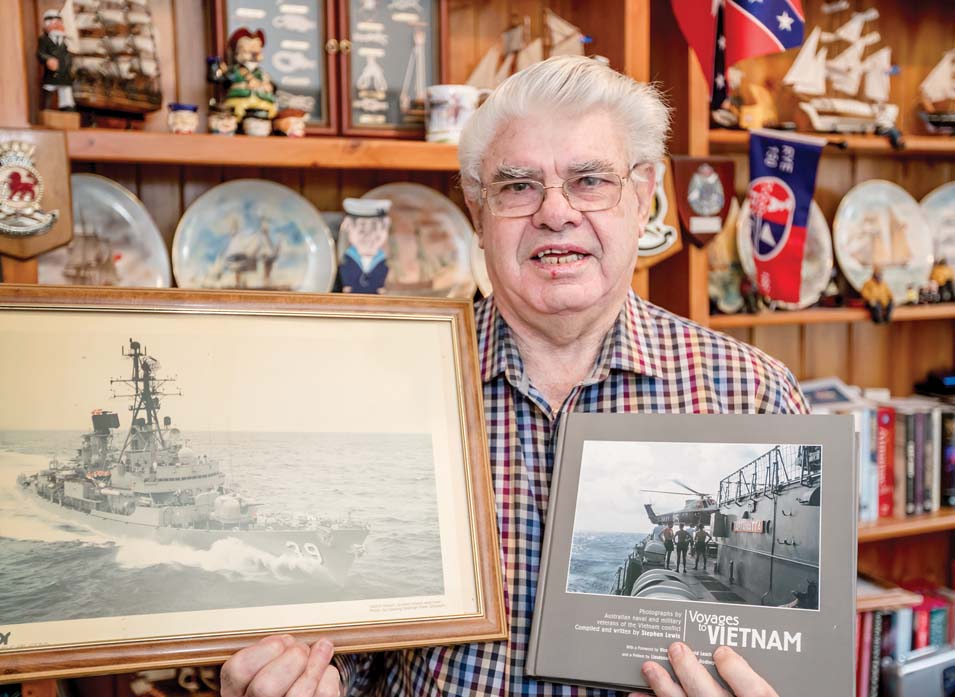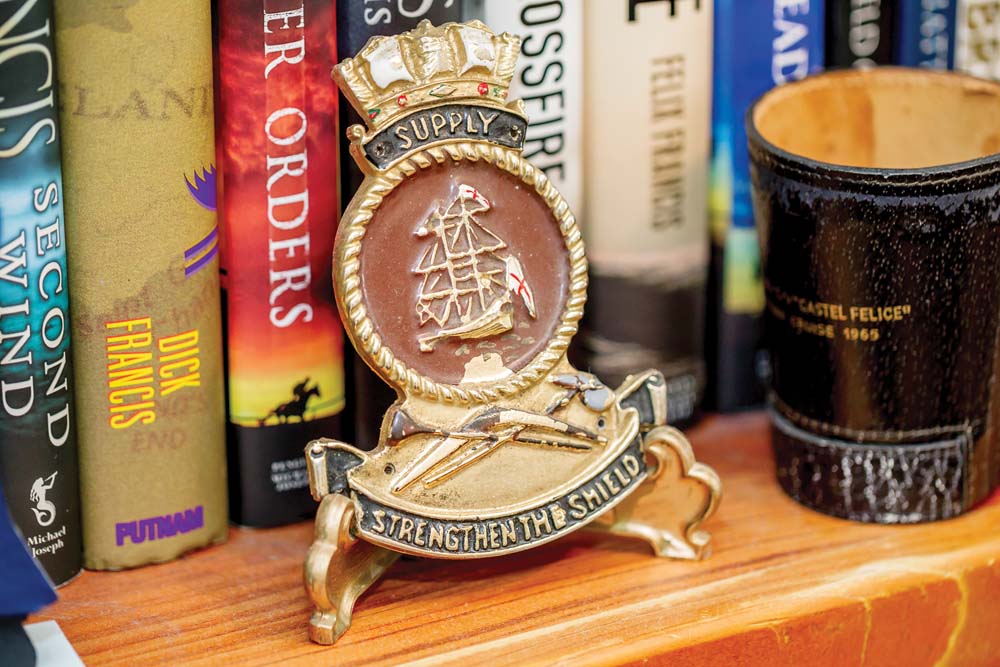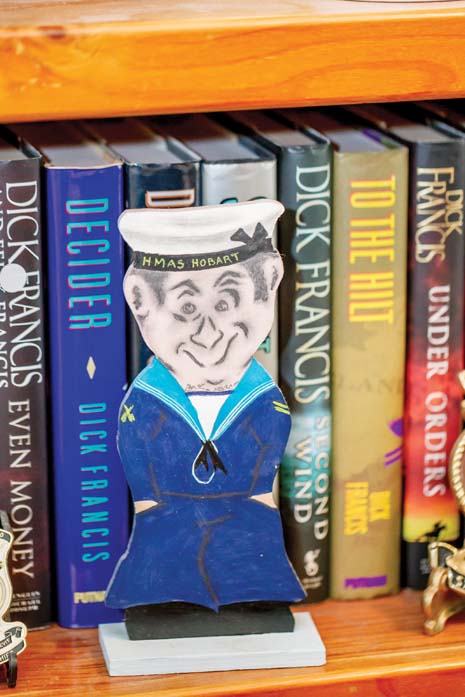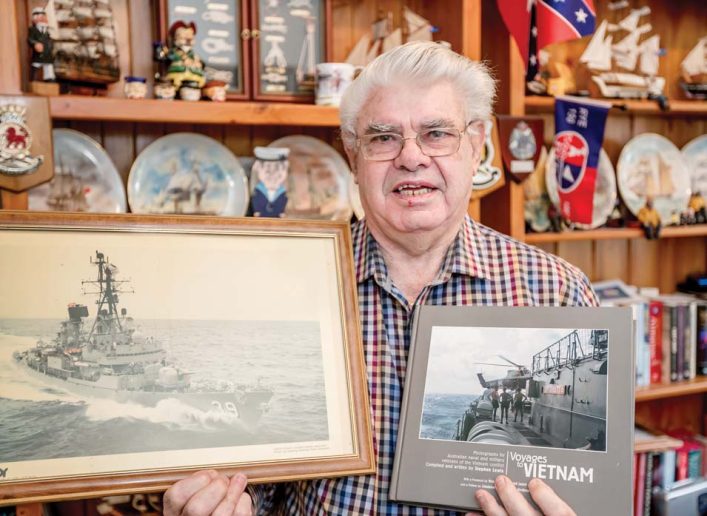
A RYE man and former sailor who served in waters off Vietnam feels honoured to have been allowed to perform his own memorial service at the site of a deadly “friendly-fire” attack on HMAS Hobart.
The mysterious Sparrow-type, three-missile attack, made in error during the Vietnam war by US Phantom jets on 17 June 1968, left two Australian seamen dead and seven injured and the guided missile destroyer badly damaged.
A US Navy board of inquiry investigating the Hobart “incident” for the Australian government later found shortcomings with the F4 Phantom jet’s radar system were partly to blame.

Wayne Bastow, a member of Rye RSL, Rye Lions and the Rye Historical Society, says the event is notable because this Saturday, 18 August, is Vietnam Veterans Day and 2018 is the Hobart’s 50th anniversary.
Earlier this year, Mr Bastow and his son, Andrew, 40, were given permission by Vietnamese authorities to return by ferry to the spot eight kilometres offshore from the demilitarised zone on the 17th parallel which once separated North Vietnam from the former South Vietnam.
The ferry – which runs from Dong Ha to Tiger Island – stopped for 15 minutes to allow Mr Bastow to pay his respects to the dead.
“I laid the three wreaths where HMAS Hobart was attacked by friendly fire,” he said.
“I am the only Vietnam RAN person to be given permission to return to the battle scene at sea to conduct my own memorial service.
 “Unfortunately, this is an untold story of the Vietnam War and no one generally knows of the events that led to the ‘friendly fire’ missile attack on the Hobart.
“Unfortunately, this is an untold story of the Vietnam War and no one generally knows of the events that led to the ‘friendly fire’ missile attack on the Hobart.
“During the four hours of the battle, around 3am, 16-17 June, [some sources in the US Navy] claimed 30 Russian-made helicopters were involved and that 12 were shot down. This proved to be false. There were no helicopters.
“The pilots of the Phantoms were mistakenly seeing pings on their radars which they mistook for helicopters but which were actually ships – their own ships.
“We could not have been helicopters because we were too big, the explosions [the missiles were causing] were too big, and we were returning heavy fire.”
Mr Bastow was in the position to know: He was in a gunner on the Hobart which fired five rounds at what they presumed was an enemy aircraft – because it was firing them.
He said that despite the two deaths the ship was lucky as one of the live missiles buried deep near the magazine failed to detonate. “If it had exploded the whole ship would have gone up and I wouldn’t be talking to you now.”
So, the largest combined land, sea and air battle of the war after the US Marines, Air Force, Navy and the US Coast Guard became involved was not really a battle at all – more of a tragic chain of events.
“One US patrol boat was sunk with five [seamen] killed and two injured and another patrol boat claimed it was engaged in a cat-and-mouse fight with two Russian-made helicopters and they shot one down. This was never verified,” Mr Bastow said.
He said the heavy cruiser USS Boston was hit by two missiles and the destroyer USS Edson had two missiles fired at it but both missed.
The Hobart limped back to the US naval base at Subic Bay in the Philippines. After 35 days of repairs the crew sailed it back to the so-called “Gunline” off Vietnam.
A furious Australia Prime Minister John Gorton was said to have ordered the head of the US Pacific Fleet, Admiral J J Hyland, to repair the Hobart with the US to pay all damages. He ordered a full inquiry by the end of June of that year with the findings to be published by mid-July.
“All that happened,” Mr Bastow said. “However, the supposedly 30 Russian-made helicopters were put down as possibly unidentified flying objects.”
Mr Bastow said the incident, although not a secret, was “an embarrassment to the US – and our government does not want the story told”.
“The story belongs to all Australia as the RAN ship was flying an Australian flag and doing its duty in Vietnam.”
First published in the Southern Peninsula News – 14 August 2018



